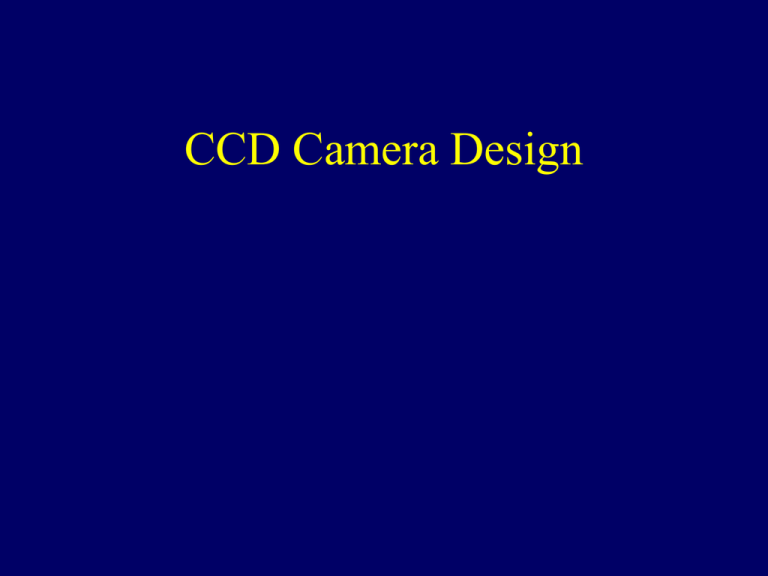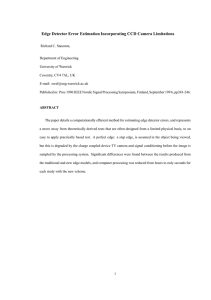CCD Camera Design
advertisement

CCD Camera Design Camera Construction Techniques 1. The photo below shows a scientific CCD camera in use at the Isaac Newton Group. It is approximately 50cm long, weighs about 10Kg and contains a single cryogenically cooled CCD. The camera is general purpose detector with a universal face-plate for attachment to various telescope ports. Mounting clamp Pre-amplifier Pressure Vessel Vacuum pump port Camera mounting Face-plate. Liquid Nitrogen fill port Camera Construction Techniques 4. A cutaway diagram of the same camera is shown below. Thermally Insulating Pillars Electrical feed-through Vacuum Space Pressure vessel Pump Port Telescope beam Face-plate CCD Focal Plane of Telescope Optical window ... CCD Mounting Block Thermal coupling Boil-off Nitrogen can Activated charcoal ‘Getter’ Camera Construction Techniques 5. The camera with the face-plate removed is shown below CCD Retaining clamp Temperature servo circuit board Aluminised Mylar sheet Gold plated copper mounting block Top of LN2 can Platinum resistance thermometer Pressure Vessel ‘Spider’. The CCD mounting block is stood off from the spider using insulating pillars. Location points (x3) for insulating pillars that reference the CCD to the camera face-plate Signal wires to CCD Camera Construction Techniques 6. A ‘Radiation Shield’ is then screwed down onto the spider , covering the cold components but not obstructing the CCD view. This shield is highly polished and cooled to an intermediate temperature by a copper braid that connects it to the LN2 can. Radiation Shield Camera Construction Techniques 7. Some CCDs cameras are embedded into optical instruments as dedicated detectors. The CCD shown below is mounted in a spider assembly and placed at the focus of a Schmidt camera. CCD Signal connector (x3) Copper rod or ‘cold finger’ used to cool the CCD. It is connected to an LN2 can. ‘Spider’ Vane CCD Clamp plate Gold plated copper CCD mounting block. FOS 1 Spectrograph CCD Package Infrared Camera Design Differences to CCD cameras Basic Optics Example: NIRI Gemini Near-Infrared Imager (NIRI) K. W. Hodapp, J. Hora, E. Graves, E. Irwin, H. Yamada, D. Neill J. Douglass, K. Fletcher, T. Young R. Chung, L. Robertson Institute for Astronomy NIRI • • • • • • • 1.0 - 5.5 m Imager for Gemini North 3 Cameras: 117, 50, 22 mas/pixel Polarimetric Capability Grism Spectroscopy Coronographic Capability Pupil Viewer IR On-Instrument Wavefront Sensor Technical Challenges • • • • • • Minimize Flexure Lens Mount for Fast and Aspheric Lenses Bearings Bushing Material Selection Filter Wheel Design Connector Corrosion NIRI OIWFS: Detector: HAWAII-1 engineering grade Readnoise: 7 e- rms (sub-arrays, multi-sampled) Near-infrared Imager (NIRI) HAWAII-1 Detector OIWFS gimbal NIRI OIWFS • HAWAII-1 detector used in combination with a SH on instrument wavefront sensor to provide fast tip/tilt/focus • Demonstrated to work down to J~15 mag stars at 100 Hz • Gimbal mirror at pupil used to steer guide stars across ~3.5 arcmin FOV into OIWFS • Improved sky coverage vs. optical sensing • Permits wavefront sensing in “dark clouds” NIRI Science Module Detector: Aladdin II 10241024 InSb detector array, 27m pixels Readnoise: 20 e- rms multi-sampled Dark Current: 0.2 e-/s (30 K) NIRI: f/6 optical path NIRI f/6: spot image in corner NIRI f/32: spot image K’ NIRI f/32: spot image M’

